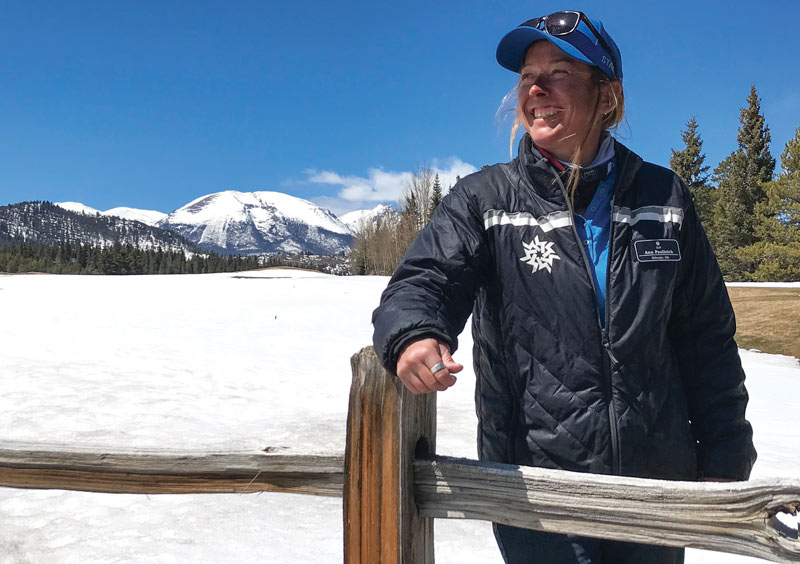
Author Ann Paulisich, an 11-year GCSAA member, takes a break from mowing greens at Keystone Ranch Golf Course in Keystone, Colo., in April — a week ahead of another forecast for a foot of snow. Photo by Steve Corneillier
It all began for me on the eighth hole of the local country club golf course in Stillwater, Minn.
When I was young, our neighborhood gang would wade through ponds looking for golf balls and steal matches from tee boxes to light things on fire. It was a traditional country club, with men on the course, in the bar and filling the clubhouse. I rarely saw women at the club. That is just how it was. I got to play in junior league every Friday morning and eat doughnuts for breakfast.
I was naive and happy.
Then, in ninth grade, I joined the golf team, and my perceptions began to change. I remember being upset that the tee times available to me, a female golf team member, were limited, so I spent most of my practice time on the driving range and little time on the course actually playing golf.
The following year, I decided to take a job at the country club. I was hired on the grounds crew and was, of course, the only female on staff. I was so nervous my first day. I was going to work with all the popular boys in school! Although I was a tomboy, I thought I would show up for my first day dressed as a “girl.” (What was I thinking?)
I woke up at 4 a.m., took a shower, curled my hair and went to work. I walked in, and laughter ensued.
I heard, “Did you actually take a shower before work?” and “Who gets ready for work?” and “Don’t you know you roll out of bed five minutes before work?” I was so embarrassed.
As if that weren’t enough humiliation for the day, for my first task, the superintendent took me out to the Cushman and asked whether I could drive a stick.
Of course I couldn’t, so I had to drive him around the golf course, stalling at every stop. I could see the male golfers laughing at me, and my male co-workers questioned why I was hired. That first day was challenging. However, I made it through training, and I fell in love with the job.
Perseverance, and Penn State
My three high school years working at the country club were quite a learning experience. My male co-workers did not respect me. I was teased and thrown in the pond. I became discouraged when the water coolers were too heavy for me and I would get covered in sloshing water, or when the string trimmer wouldn’t start for me, pull after pull.
But I endured and stuck it out for another four years while I attended college and earned my degree in business management.
During those seven years at the country club, one more surprising event transpired — I decided this was what I wanted to do for the rest of my life. This decision led me to apply to Penn State’s turfgrass management program. I was the only woman in my class, a small, tightknit group of 30.
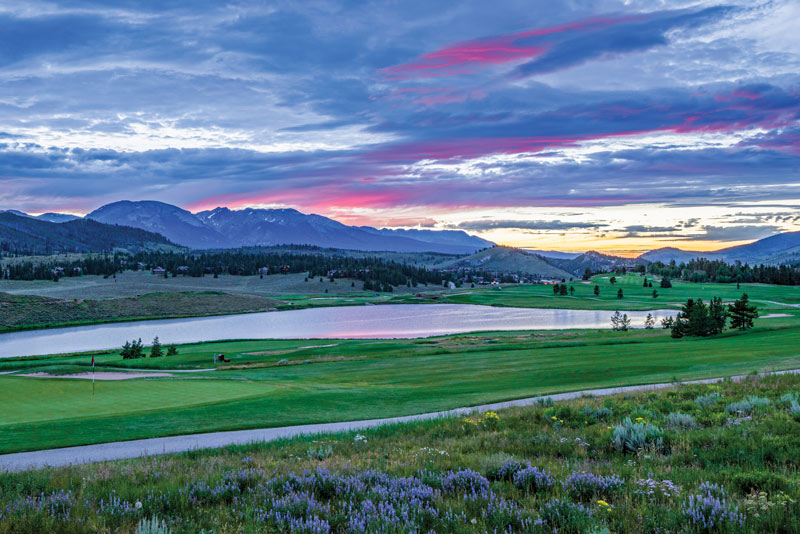
The 18-hole Keystone Ranch Golf Course was designed by Robert Trent Jones Jr. and opened in 1980. Photo courtesy of Ann Paulisich
In 1996, it seemed the perception of a woman in the program was wide-ranging. A few classmates treated me just like the others. Some wouldn’t give me the time of day. Others just flirted and wanted to go get beers.
I graduated at the top of my class.
A rocky start
Part of the turfgrass management program was to complete an internship, and I was stoked to get an internship at a prestigious country club. I knew I was in for a challenge, but I was motivated, educated and ready. At least, I thought I was.
On my first day as an intern, my trainer was apparently unaware that I was an educated professional, because he decided to present me with some unsavory sights (your imagination is probably correct here). He was removed from the staff that afternoon and did not return. That unfortunate incident was quickly addressed and a singular occurrence, but I was not off to a great start.
Editor’s note: The findings of a recent survey of women in turf highlight the unique challenges women face in pursuing careers in the industry.
However, this was not the most challenging part of my internship. My real challenge was gaining the respect and responsibility I deserved. While the other interns were assigned a variety of difficult, physical duties, I was given the “easy” tasks. The superintendent said it was because of my attention to detail, but I think he was just taking it easy on the girl. I begged to be given physically demanding tasks and more responsibility. On the rare occasions I was assigned the tasks I requested, it felt rewarding and gave me a small sense of accomplishment.
Once I was finally out of school and had completed my internship, I headed off to begin my career — at two jobs in separate corners of the country, with two drastically different experiences.
A tale of two staffs
My first stop was as the second assistant at a TPC course in Las Vegas. It was a whole new world, in a good way. The management team was as I expected, but the staff was primarily Hispanic — and fantastic. Fortunately, I speak some Spanish, so I could talk with the staff. It was a pleasure to do this job I loved with people who respected me and each other. I enjoyed two summers in the desert heat, hosting several professional events, before I moved up to Oregon for an assistant position.
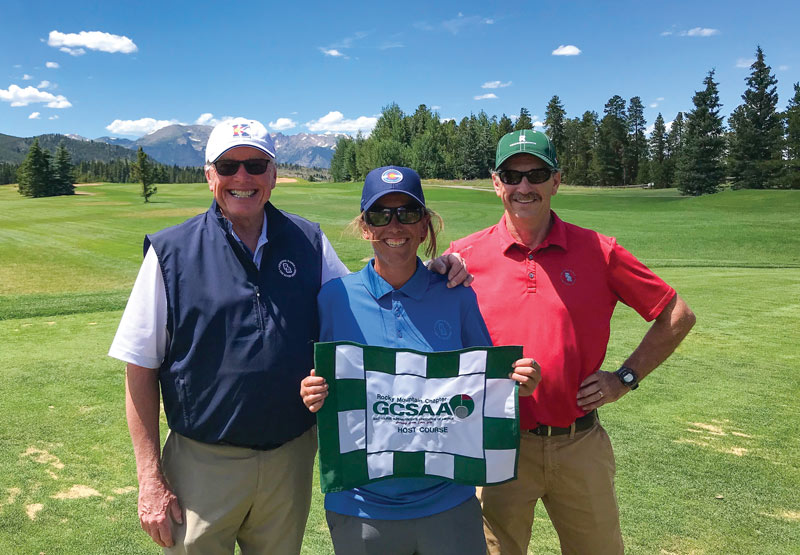
Three “generations” of superintendents at Keystone Ranch Golf Course (from left): Steve Corneillier, retired director of golf and recreation, a 31-year GCSAA member; current superintendent Ann Paulisich; and Brett Lockard, CGCS, former director of golf course maintenance and a 30-year GCSAA member. Photo courtesy of Ann Paulisich
The management staff in Oregon was similar to that in Las Vegas; however, the culture of the crew was quite different. The crew, again mostly Hispanic, had a leader who translated for management and the staff, and it quickly became apparent that the crew wasn’t receptive to taking orders from a woman. Oh, boy.
Unfortunately, I had many extremely difficult encounters with the crew that could have been toxic for me professionally and personally, but I had some crazy willpower to succeed and overcome the challenges that continued to push me down. I don’t know how, or why, but I lasted five years there.
Editor’s note: Learn more about women blazing trails in the turf industry and read more of their stories and insights in GCMOnline.com’s women in turf collection.
Those years, however, took a toll. Eventually, I became mentally defeated and had to take a winter off. I moved home with my mom and reevaluated what to do professionally.
A career restart
After a break, I knew that my passion for golf and the turfgrass profession was still strong. I had a good support system, motivation and encouragement to try again. Colorado was finally the turning point for me personally and professionally.
When I arrived in Keystone, Colo., in 2005, I worked with my first female superintendent — Pam Brown, a now-retired GCSAA Class A superintendent and a 20-year association member. Hallelujah! There really were other women in this industry.
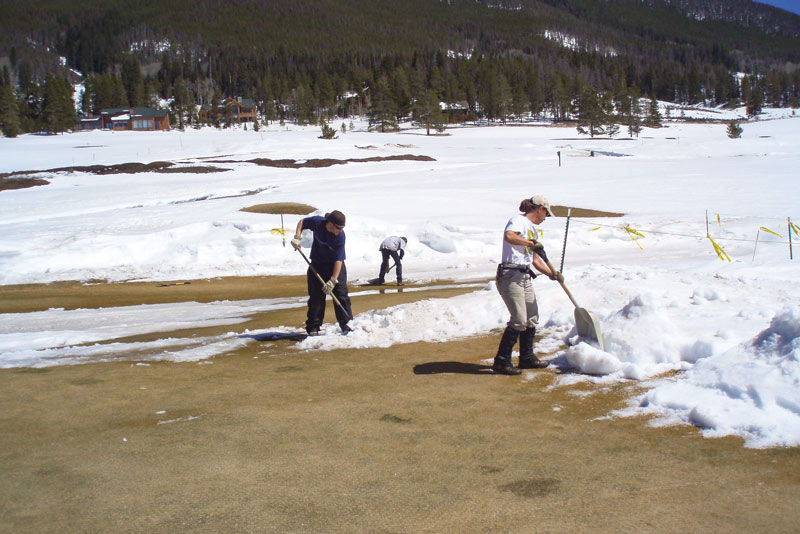
Clearing snow off the greens is a common task at Keystone Ranch Golf Course. Here, it’s being tackled by former superintendent Pam Brown (right) and crew. Photo courtesy of Ann Paulisich
Surprisingly, though, I faced many of the same challenges I had with male superintendents. Again, I felt like I was treated differently because I was female. On my first day, a young man who was the special-project person was angry that I “took his job.” He said I got the good jobs just because I was a woman.
I talked to my superintendent about the challenges I faced and my desire to earn my place, and she agreed to let me work my way up. I enjoyed this. It was a welcomed gift. As I proved my abilities and knowledge to the staff, I gained their respect. I learned to believe in myself, and I learned that I could truly be my best when I was given opportunity, tools and support.
I have been at Keystone Ranch for 15 years now. I was promoted to superintendent in 2019. I work for a company with values that I can stand behind and a company that believes that we are stronger when we support diversity, equity and inclusion.
It has been a bumpy ride, but I can confidently say that my experience in the golf industry has made me the person I am today — a strong female leader — and I like who I am.
Career wisdom from Ann Paulisich
Being a superintendent is challenging regardless of gender. Here are a few words of wisdom, applicable to anyone.
Golf!
Play golf. I cannot emphasize how much being a player has helped me throughout my career. It’s the best way to see my course and really understand how it’s playing. I like to walk, too. It’s amazing how much I see. When I play with friends, I try not to work, and focus on having fun. Just enjoy the game. Members, guests and staff enjoy seeing superintendents who play. It has always helped me gain respect.
Vision
Whether you’re 14 or 30, know what you are working for in life. Make choices to support this vision.
Teamwork
One of the most difficult things for me is turning off my competitive side. I always strive to be the best, and I always need to make sure my drive aligns with the goals of the team.
Fun
It’s just turf and a game. Laugh at your mistakes, and help others feel better when they mess up.
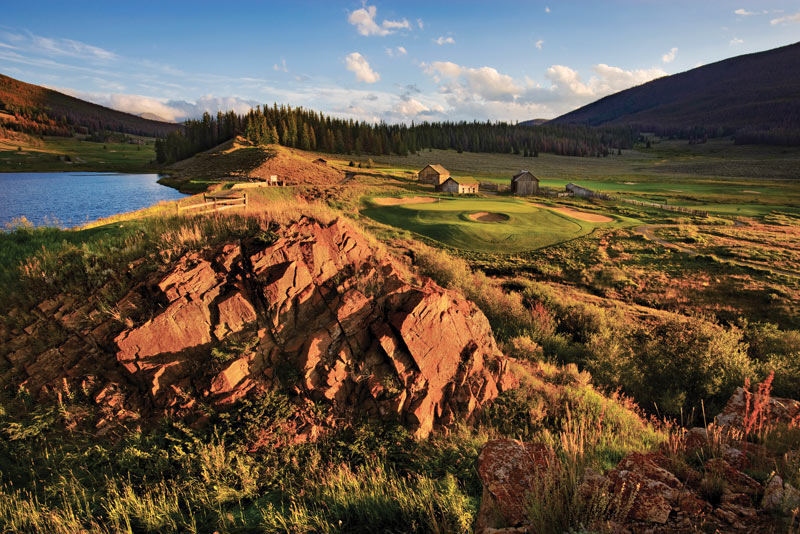
Keystone Ranch Golf Course at its fall finest. Photo by Allen Kennedy
Knowledge
This is a hard job. Superintendents are expected to know more than turf and golf. Mechanics has always been hard for me. I remember as a young woman checking the oil once while the engine was running. That turned out ugly. I have a strong science and golf background, so I seek people on my team who are strong in other areas.
Confidence
I walk the golf course with my head held high. I stand behind my staff and my course conditions.
Relationships
I have been criticized for getting to know my staff, being told that it interferes with my ability to lead, but I disagree. I like to talk to staff and show that I care about them as individuals, not just as employees. Building relationships with all stakeholders in the golf course and my profession keeps me afloat. I can’t do this job without help; it’s too big!
Fortune
A former superintendent once told me, “This job is one-third knowledge, one-third experience and one-third luck!”
Ann Paulisich is the superintendent at Keystone Ranch Golf Course in Keystone, Colo. She is an 11-year member of GCSAA.